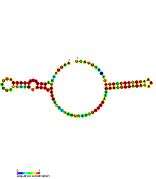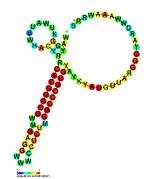Escherichia coli sRNA
Escherichia coli contains a number of small RNAs located in intergenic regions of its genome. The presence of at least 55 of these has been verified experimentally.[1] 275 potential sRNA-encoding loci were identified computationally using the QRNA program. These loci will include false positives, so the number of sRNA genes in E. coli is likely to be less than 275.[2] A computational screen based on promoter sequences recognised by the sigma factor sigma 70 and on Rho-independent terminators predicted 24 putative sRNA genes, 14 of these were verified experimentally by northern blotting. The experimentally verified sRNAs included the well characterised sRNAs RprA and RyhB. Many of the sRNAs identified in this screen, including RprA, RyhB, SraB and SraL, are only expressed in the stationary phase of bacterial cell growth.[3] A screen for sRNA genes based on homology to Salmonella and Klebsiella identified 59 candidate sRNA genes. From this set of candidate genes, microarray analysis and northern blotting confirmed the existence of 17 previously undescribed sRNAs, many of which bind to the chaperone protein Hfq and regulate the translation of RpoS (Sigma 38).[4] UptR sRNA transcribed from the uptR gene is implicated in suppressing extracytoplasmic toxicity by reducing the amount of membrane-bound toxic hybrid protein.[5]
Cell motility enhancing sRNA named Esr41, was discovered in intergenic region of pathogenic enterohemorrhagic E.coli (EHEC) O157:H7 Sakai. Esr41 sequence is not present in nonpathogenic E. coli K12, but the sRNA can induce cell motility in K12 as well, suggesting that target genes controlled by Esr41 are present in both E.coli.[6]
Trans-encoded small RNA RalA has 16 nucleotides complementary to coding region of toxin RalR mRNA. RalA functions as an antitoxin by preventing translation of RalR (a non-specific endonuclease that cleaves methylated and unmethylated DNA). Its activity requires RNA chaperone Hfq. RalR and RalA form a type I toxin-antitoxin (TA) system. RalR/RaLA TA locus is responsible for resistance to the antibiotic fosfomycin in E.coli.[7]
Deep sequencing of RNA expressed during chemical stress and high cell density fermentation discovered 253 novel intergenic transcripts adding to roughly 200 intergenic sRNAs previously described in E. coli. Several of the sRNAs exhibited specific expression patterns during high cell density fermentation and are differentially expressed in the presence of multiple chemicals, suggesting they may play roles during stress conditions. The novel sRNAs showing differential expression in several stress conditions were: ES003, ES036, ES056, ES098, ES173, ES180, ES205, ES220, ES222, ES239.[8]
Esre sRNA, for "essential small RNA in E. coli", is located in 3′ moiety of yigP gene[9] (also known as ubiJ), which is involved in coenzyme Q8 biosynthesis in Escherichia coli and Salmonella enterica serovar Typhimurium.
AgrB antisene RNA (arsR-gov region gene B) is transcribed opposite of dinQ (translates into a toxic single transmembrane peptide) with 30 complementary nucleotides. AgrB appears to repress accumulation of dinQ by RNA interference and counteracts its toxicity.[10]
- Mycobacterium tuberculosis sRNA
- Pseudomonas sRNA
- Bacillus subtilis BSR sRNAs
- Caenorhabditis elegans sRNA
- List of RNA structure prediction software
References
- Hershberg R, Altuvia S, Margalit H (April 2003). "A survey of small RNA-encoding genes in Escherichia coli". Nucleic Acids Research. 31 (7): 1813–1820. doi:10.1093/nar/gkg297. PMC 152812. PMID 12654996.
- Rivas E, Klein RJ, Jones TA, Eddy SR (September 2001). "Computational identification of noncoding RNAs in E. coli by comparative genomics". Current Biology. 11 (17): 1369–1373. doi:10.1016/S0960-9822(01)00401-8. PMID 11553332.
- Argaman L, Hershberg R, Vogel J, Bejerano G, Wagner EG, Margalit H, Altuvia S (June 2001). "Novel small RNA-encoding genes in the intergenic regions of Escherichia coli". Current Biology. 11 (12): 941–950. doi:10.1016/S0960-9822(01)00270-6. PMID 11448770.
- Wassarman KM, Repoila F, Rosenow C, Storz G, Gottesman S (July 2001). "Identification of novel small RNAs using comparative genomics and microarrays". Genes & Development. 15 (13): 1637–1651. doi:10.1101/gad.901001. PMC 312727. PMID 11445539.
- Guigueno A, Dassa J, Belin P, Boquet PL (February 2001). "Oversynthesis of a new Escherichia coli small RNA suppresses export toxicity of DsbA'-PhoA unfoldable periplasmic proteins". Journal of Bacteriology. 183 (4): 1147–1158. doi:10.1128/JB.183.4.1147-1158.2001. PMC 94987. PMID 11157926.
- Sudo N, Soma A, Muto A, Iyoda S, Suh M, Kurihara N, Abe H, Tobe T, Ogura Y, Hayashi T, Kurokawa K, Ohnishi M, Sekine Y (2014-01-01). "A novel small regulatory RNA enhances cell motility in enterohemorrhagic Escherichia coli". The Journal of General and Applied Microbiology. 60 (1): 44–50. doi:10.2323/jgam.60.44. PMID 24646762.
- Guo Y, Quiroga C, Chen Q, McAnulty MJ, Benedik MJ, Wood TK, Wang X (June 2014). "RalR (a DNase) and RalA (a small RNA) form a type I toxin-antitoxin system in Escherichia coli". Nucleic Acids Research. 42 (10): 6448–6462. doi:10.1093/nar/gku279. PMC 4041452. PMID 24748661.
- Rau MH, Bojanovič K, Nielsen AT, Long KS (December 2015). "Differential expression of small RNAs under chemical stress and fed-batch fermentation in E. coli". BMC Genomics. 16: 1051. doi:10.1186/s12864-015-2231-8. PMC 4676190. PMID 26653712.

- Chen Z, Wang Y, Li Y, Li Y, Fu N, Ye J, Zhang H (April 2012). "Esre: a novel essential non-coding RNA in Escherichia coli". FEBS Letters. 586 (8): 1195–1200. doi:10.1016/j.febslet.2012.03.010. PMID 22575655.
- Weel-Sneve R, Kristiansen KI, Odsbu I, Dalhus B, Booth J, Rognes T, Skarstad K, Bjørås M (2013). "Single transmembrane peptide DinQ modulates membrane-dependent activities". PLOS Genetics. 9 (2): e1003260. doi:10.1371/journal.pgen.1003260. PMC 3567139. PMID 23408903.
Further reading
- Carter RJ, Dubchak I, Holbrook SR (October 2001). "A computational approach to identify genes for functional RNAs in genomic sequences". Nucleic Acids Research. 29 (19): 3928–3938. doi:10.1093/nar/29.19.3928. PMC 60242. PMID 11574674.
- Chen S, Lesnik EA, Hall TA, Sampath R, Griffey RH, Ecker DJ, Blyn LB (2002). "A bioinformatics based approach to discover small RNA genes in the Escherichia coli genome". Bio Systems. 65 (2–3): 157–177. doi:10.1016/S0303-2647(02)00013-8. PMID 12069726.
- Tjaden B, Saxena RM, Stolyar S, Haynor DR, Kolker E, Rosenow C (September 2002). "Transcriptome analysis of Escherichia coli using high-density oligonucleotide probe arrays". Nucleic Acids Research. 30 (17): 3732–3738. doi:10.1093/nar/gkf505. PMC 137427. PMID 12202758.
- Vogel J, Sharma CM (December 2005). "How to find small non-coding RNAs in bacteria". Biological Chemistry. 386 (12): 1219–1238. doi:10.1515/BC.2005.140. PMID 16336117.
- Raghavan R, Groisman EA, Ochman H (September 2011). "Genome-wide detection of novel regulatory RNAs in E. coli". Genome Research. 21 (9): 1487–1497. doi:10.1101/gr.119370.110. PMC 3166833. PMID 21665928.


